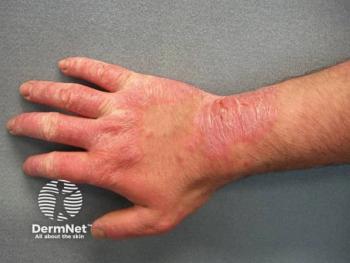
GLP-1s Emerging as Adjunct Tools in Psoriasis
Key Takeaways
- GLP-1 receptor agonists are being explored for their potential to improve psoriasis, particularly in patients with obesity.
- Ongoing trials are investigating the combination of GLP-1 agents with biologics to enhance psoriasis treatment efficacy.
Ben Lockshin, MD, FAAD, covered ways in which GLP-1 RAs can be utilized when treating psoriatic disease.
At the
GLP-1 receptor agonists, including semaglutide and tirzepatide, are well-established for their efficacy in weight reduction. However, recent clinical interest is exploring their role in improving skin conditions, particularly when used alone or in combination with biologics in patients with moderate to severe psoriasis.
“There was actually a study that focused on using semaglutide as a monotherapy to improve skin in patients with PASI [psoriasis area and severity index] scores of 10 or greater,” said Lockshin. “We saw that there was not only weight reduction, but also skin improvement, as well as improvement in DLQI [dermatology life quality index] in those patients.”
While the majority of available data focuses on weight loss as the primary end point, ongoing trials are examining the added value of GLP-1 agents in dermatology. Notably, Eli Lilly is sponsoring 2 studies investigating combination therapy using tirzepatide (a dual glucose-dependent insulinotropic polypeptide [GIP]/GLP-1 receptor agonist [RA]) and ixekizumab (an IL-17A antagonist) in patients with elevated body mass index (BMI) and moderate to severe psoriasis.
These combination trials aim to determine whether reducing BMI can enhance the efficacy of biologics in psoriasis treatment. “We also have a blinded study looking at the combination of tirzepatide and ixekizumab versus ixekizumab alone,” Lockshin noted. “This could be a game changer for patients who haven’t responded optimally to biologics due to elevated BMI.”
Access to GLP-1 agents remains a challenge. Currently, patients typically qualify based on having a BMI ≥30 or a BMI ≥27 with a recognized comorbidity—psoriasis is not yet considered one. However, patients with commercial insurance taking ixekizumab may qualify for tirzepatide at a reduced cost through manufacturer-sponsored programs.
Lockshin emphasized the importance of multidisciplinary collaboration. “If you do not feel comfortable using a GLP-1, maybe your role is just recommending it to a patient, talking about psoriatic disease and encompassing many different comorbidities, including obesity,” he advised.
As research continues, GLP-1 RAs may soon be an essential part of managing chronic inflammatory skin diseases by addressing the metabolic factors that impact treatment outcomes and quality of life.
Newsletter
Like what you’re reading? Subscribe to Dermatology Times for weekly updates on therapies, innovations, and real-world practice tips.



















